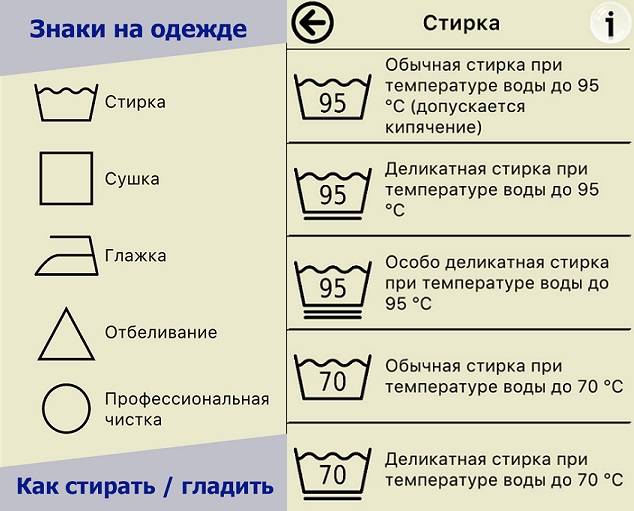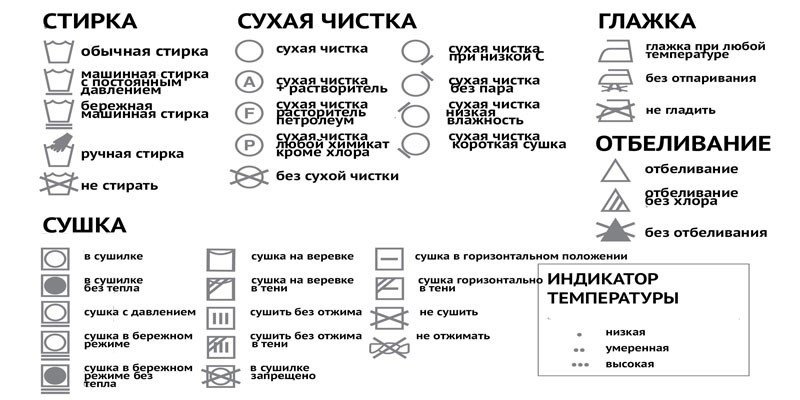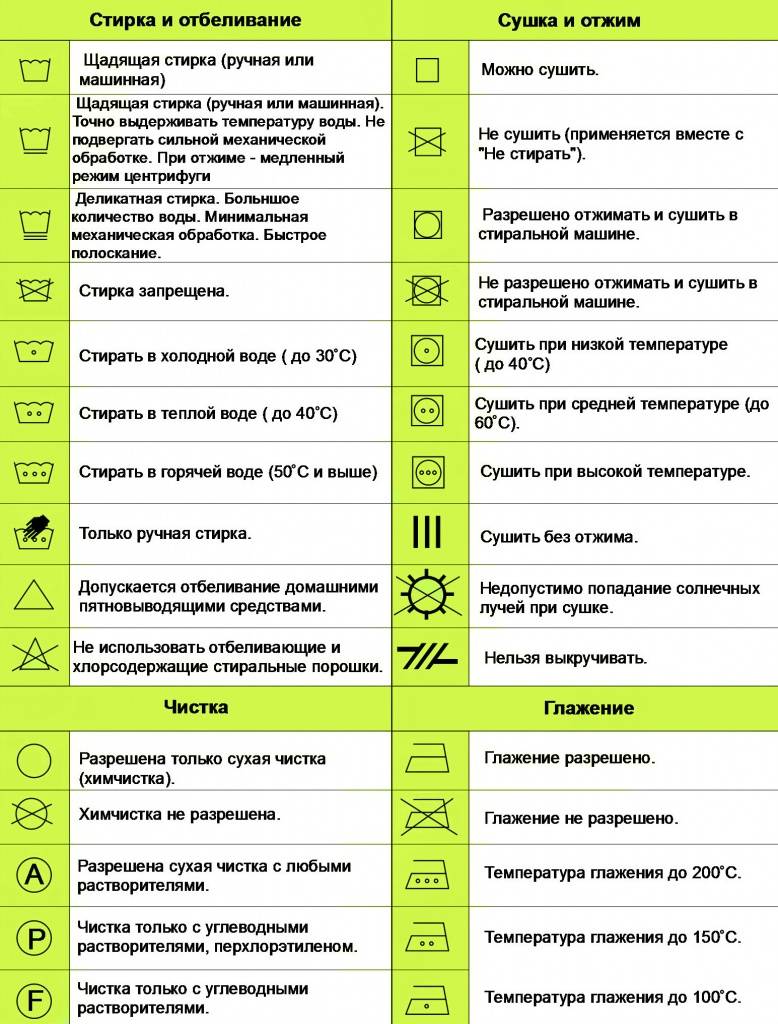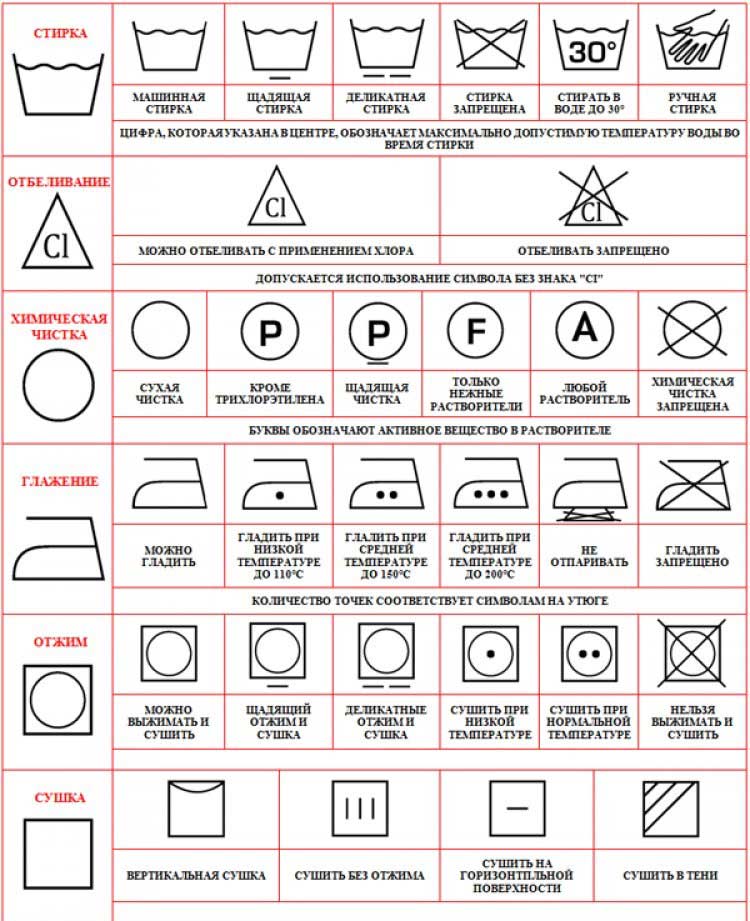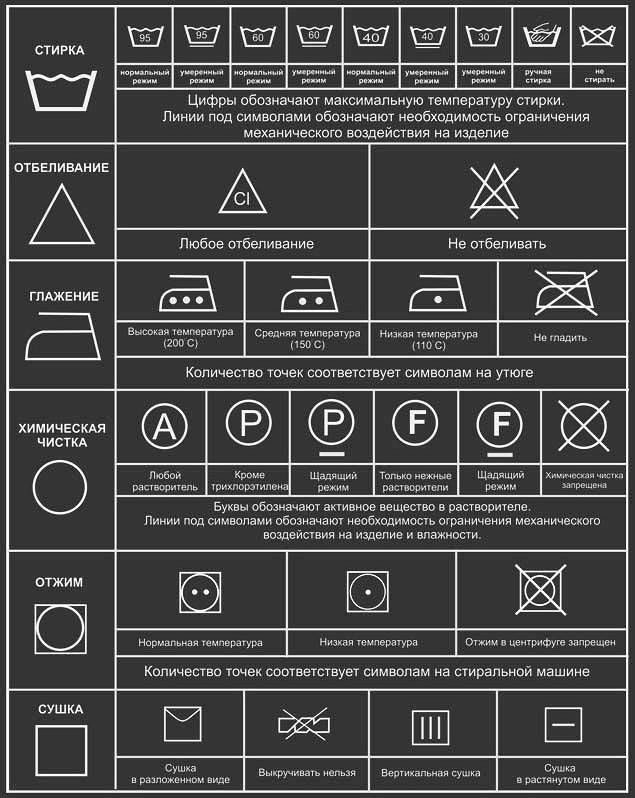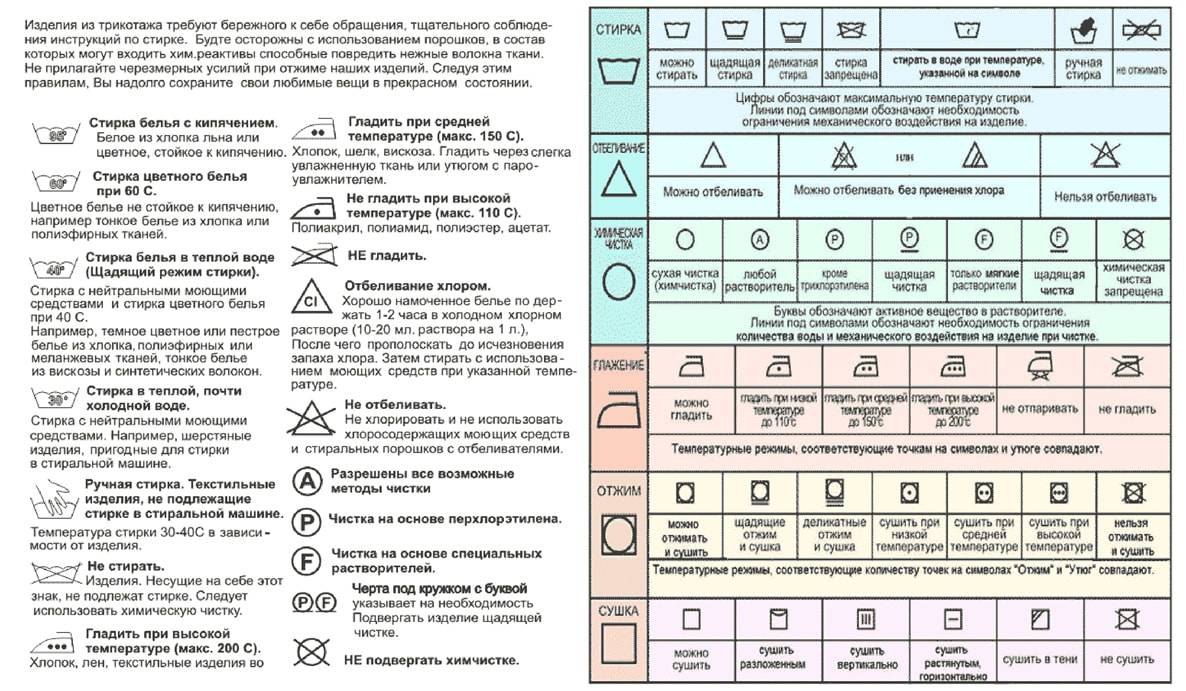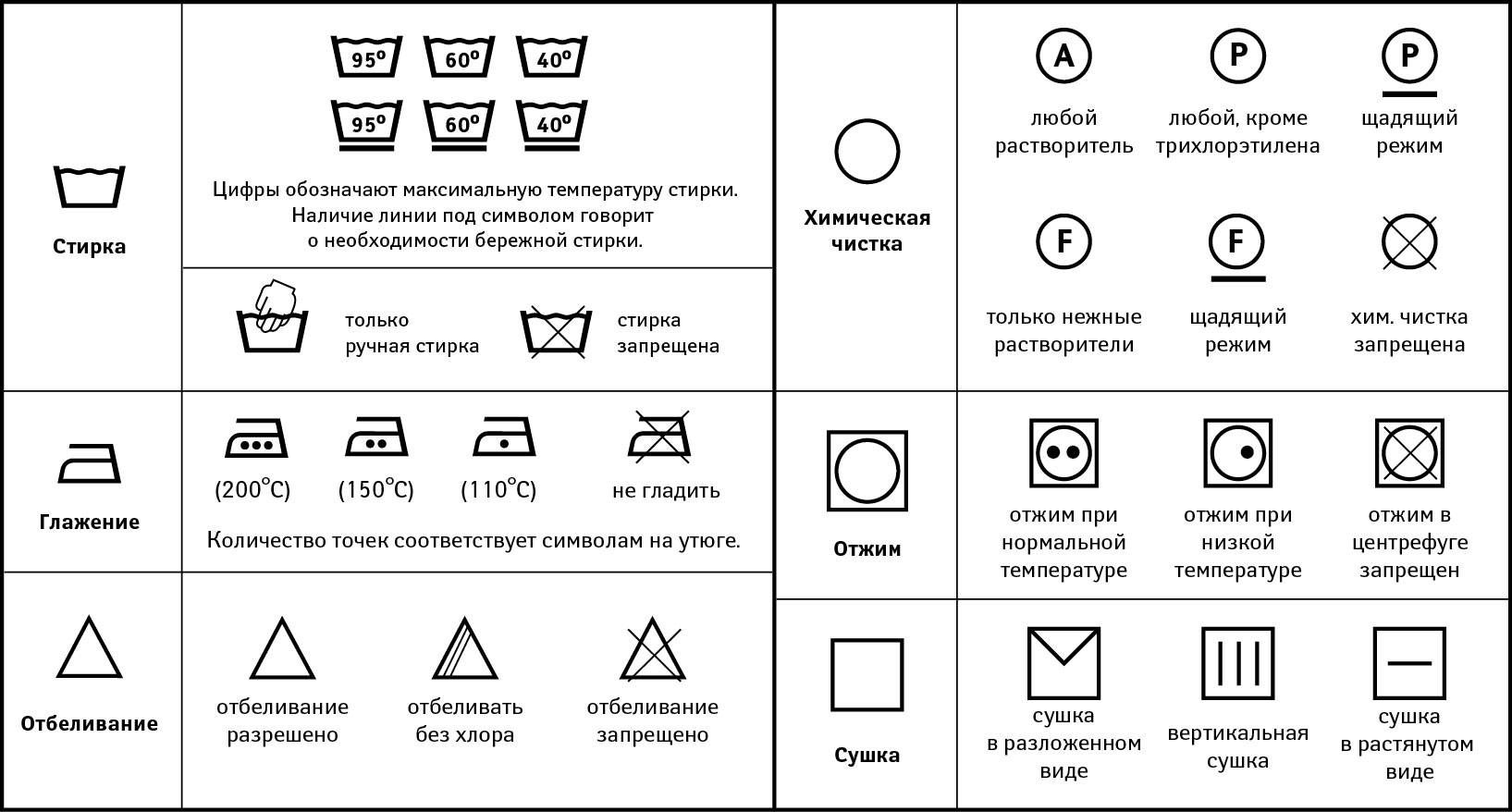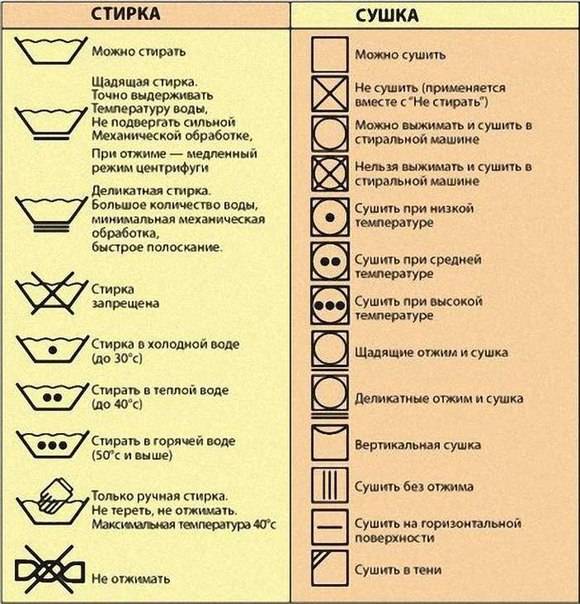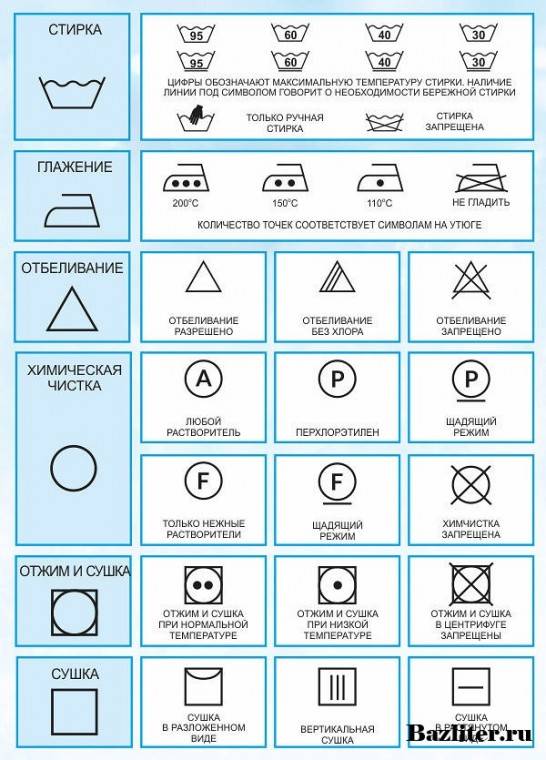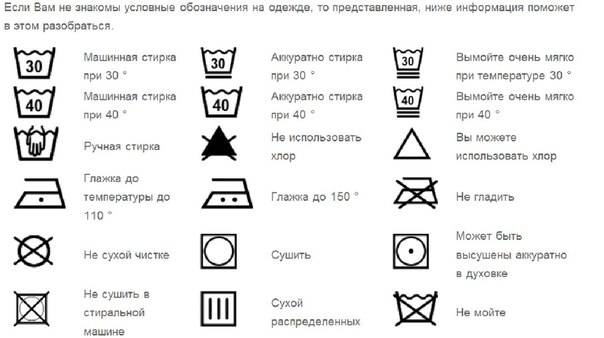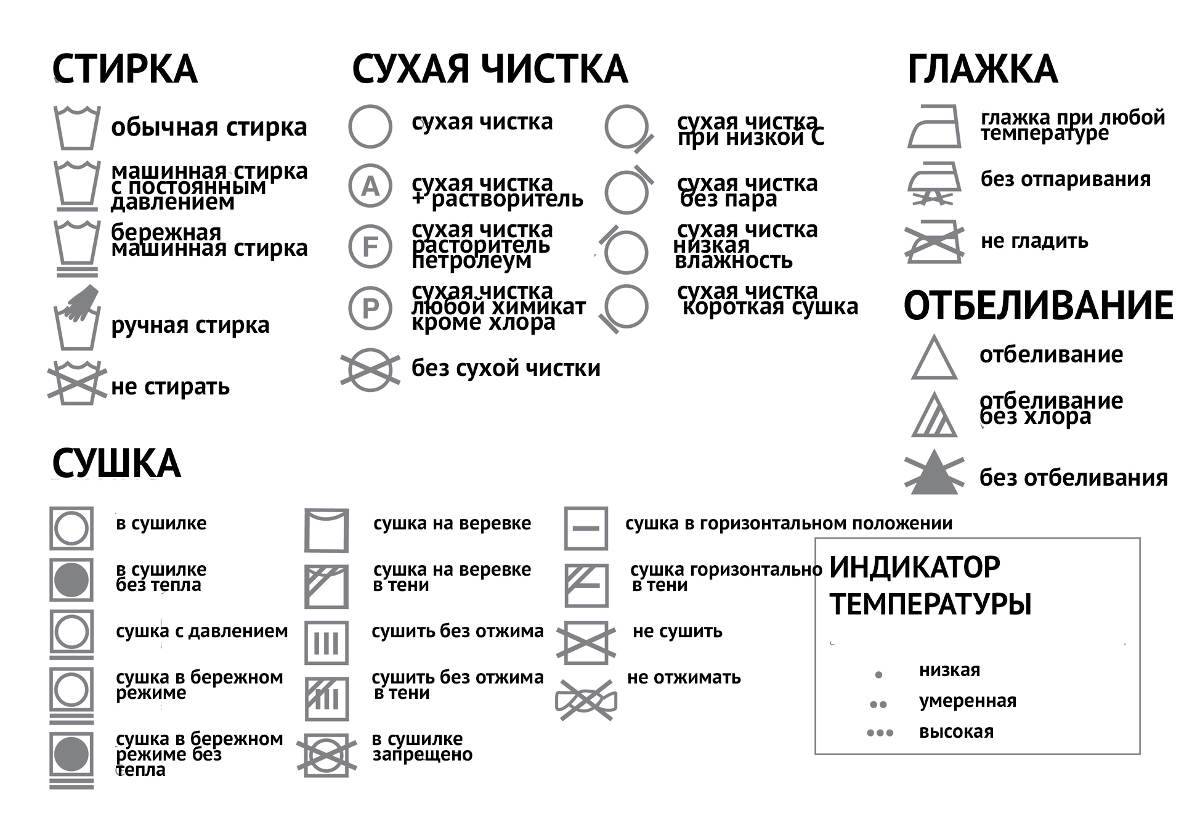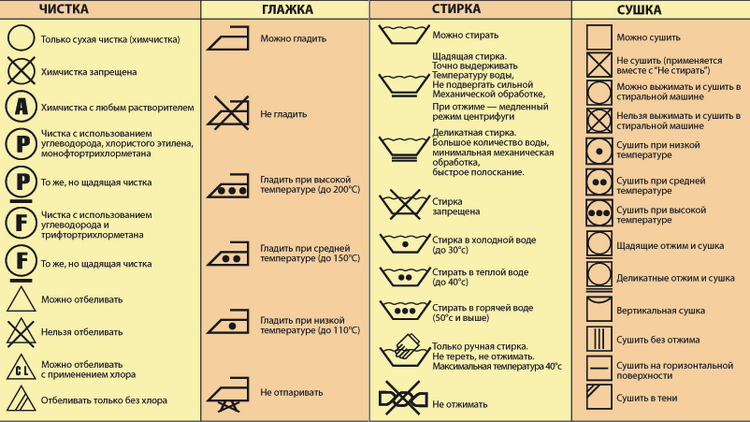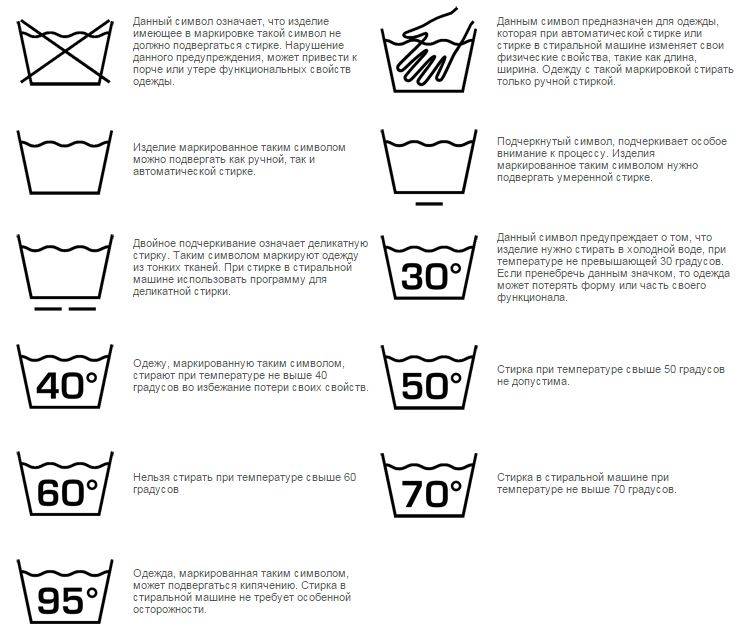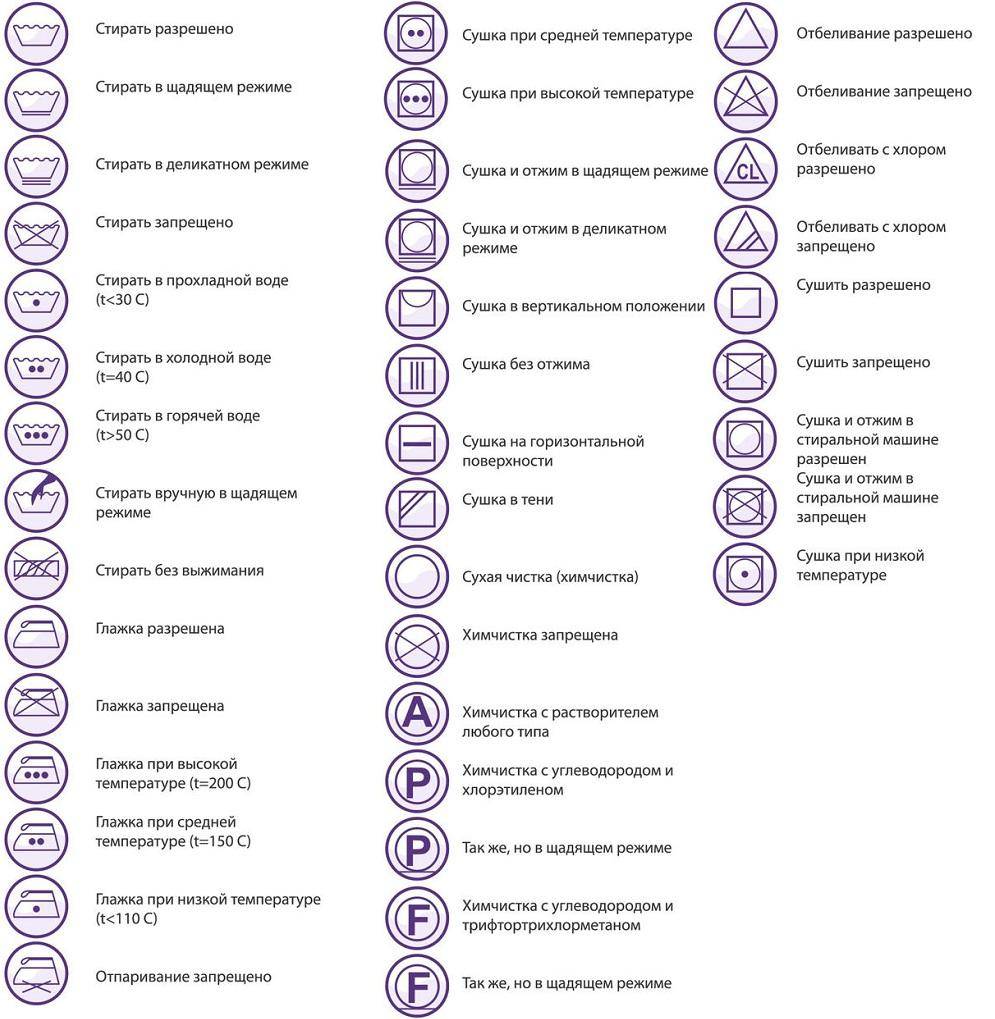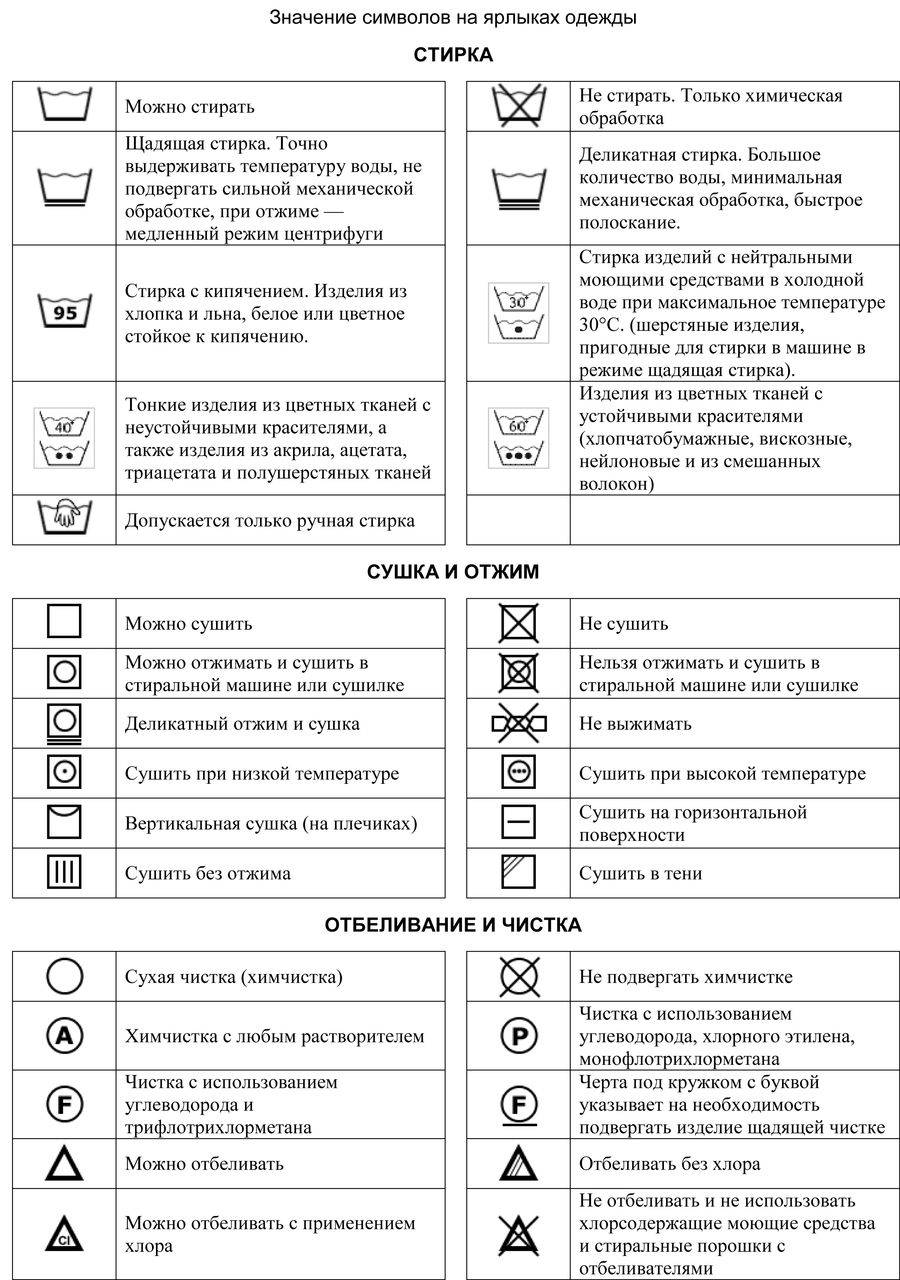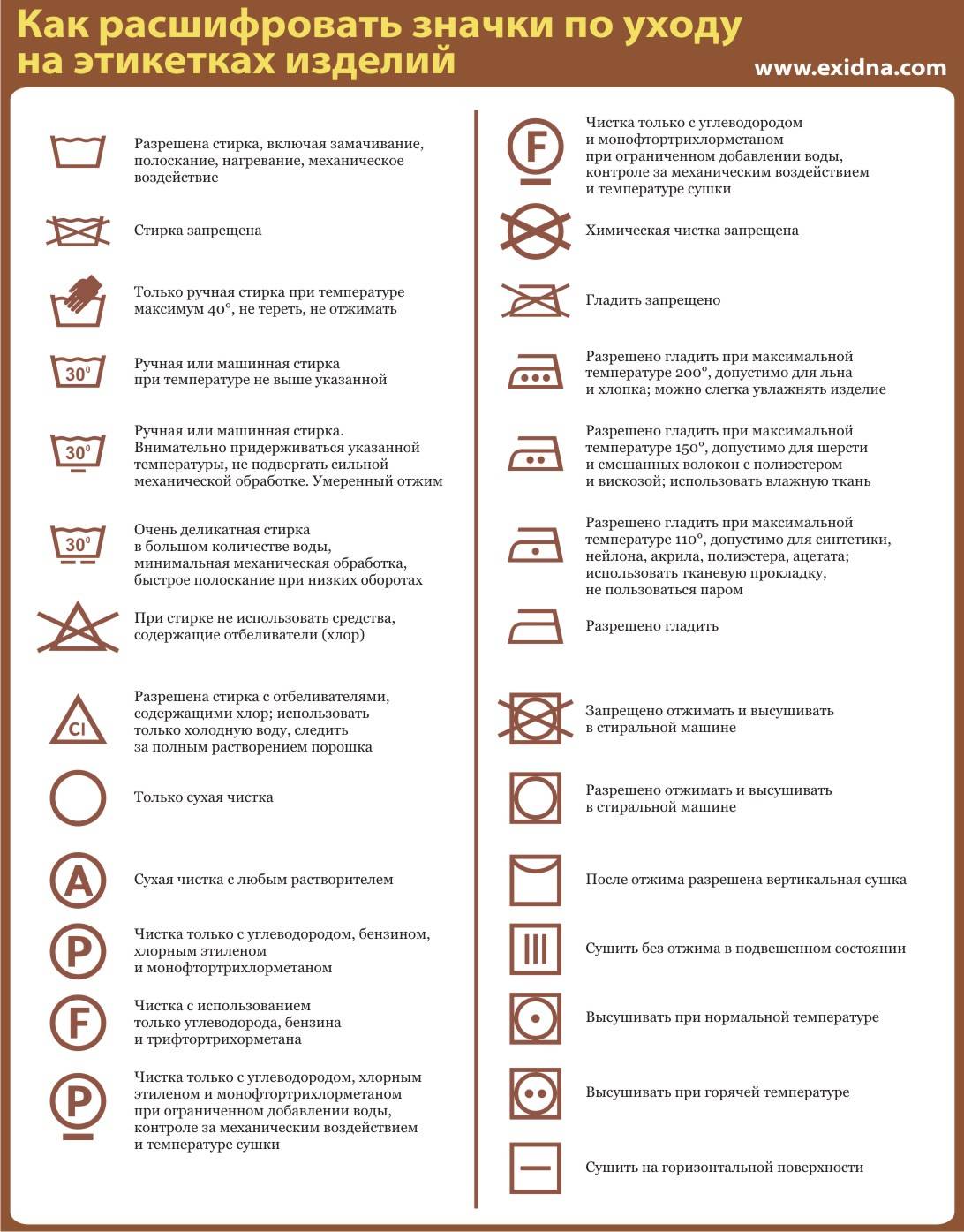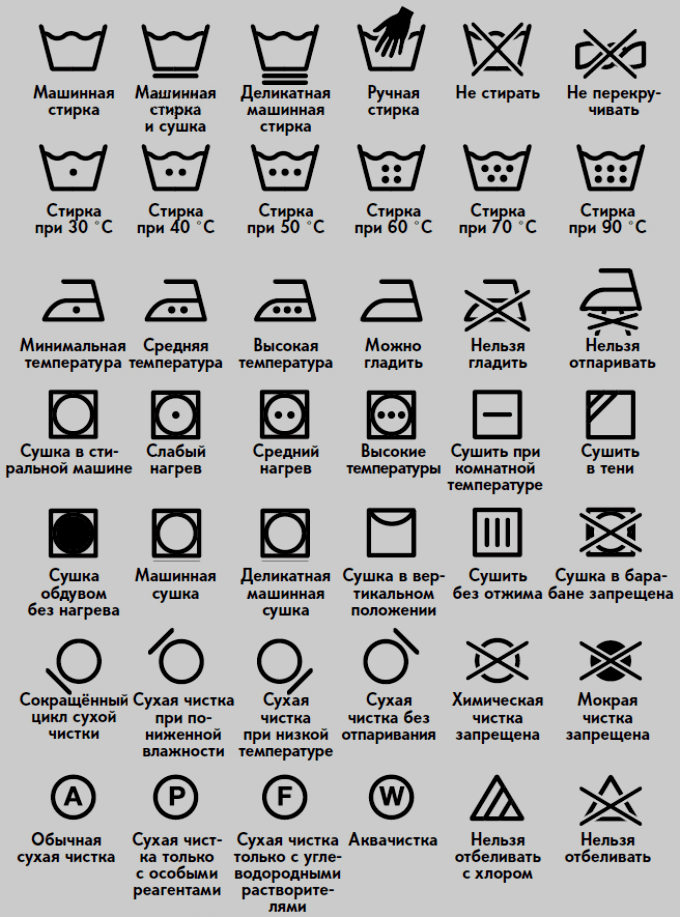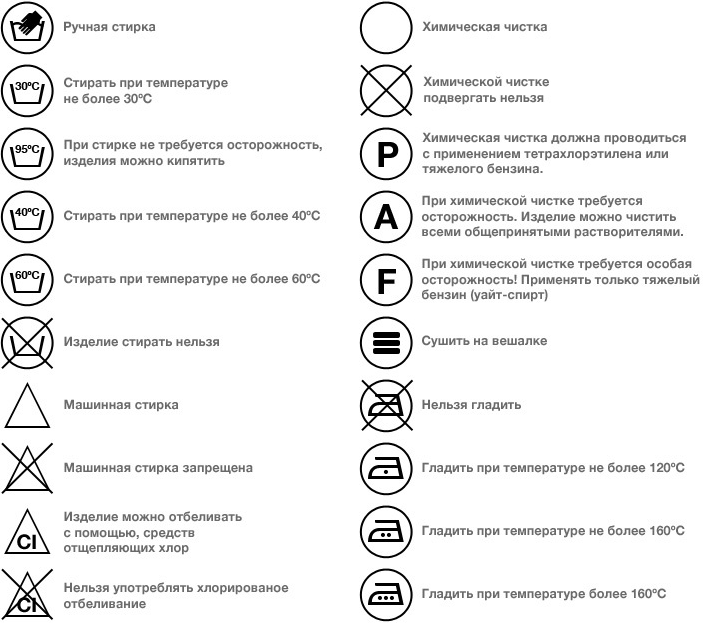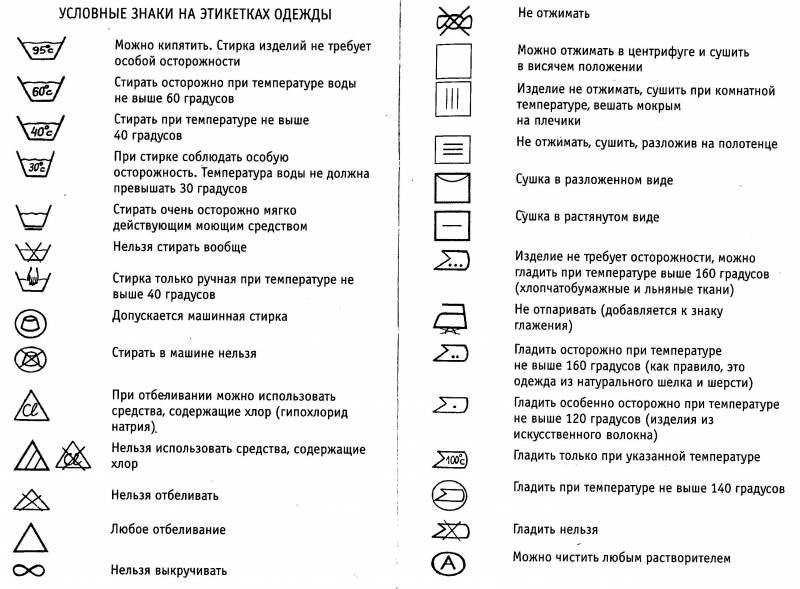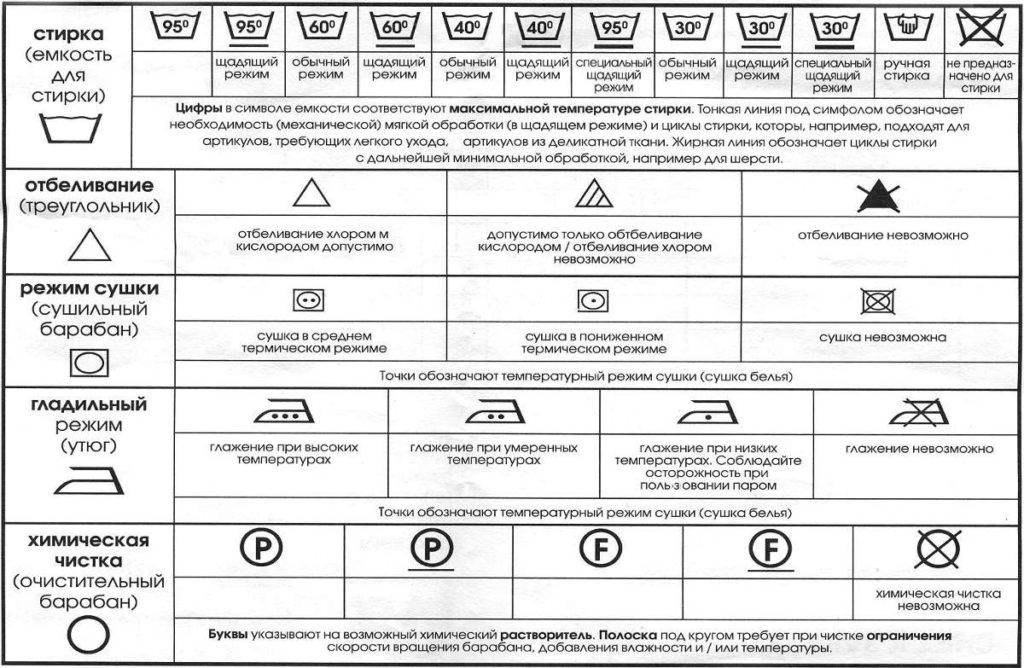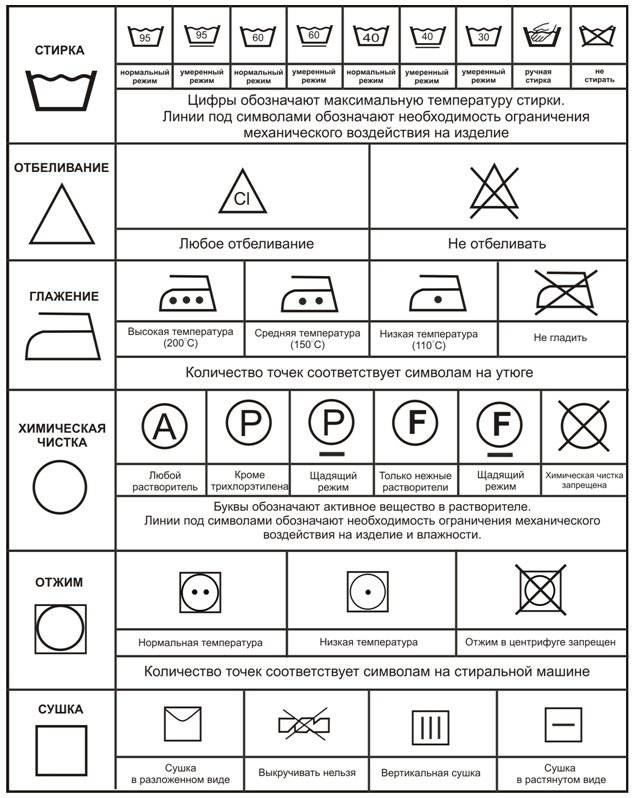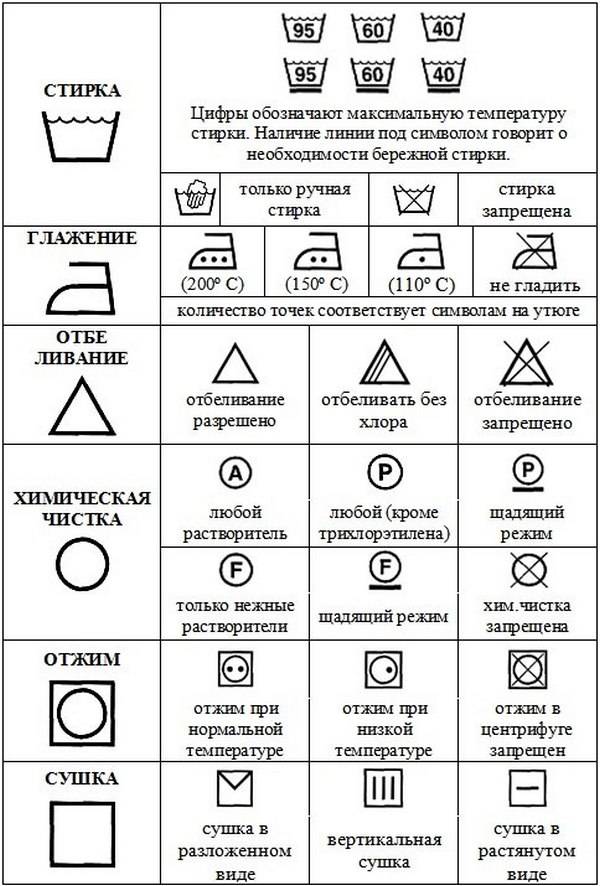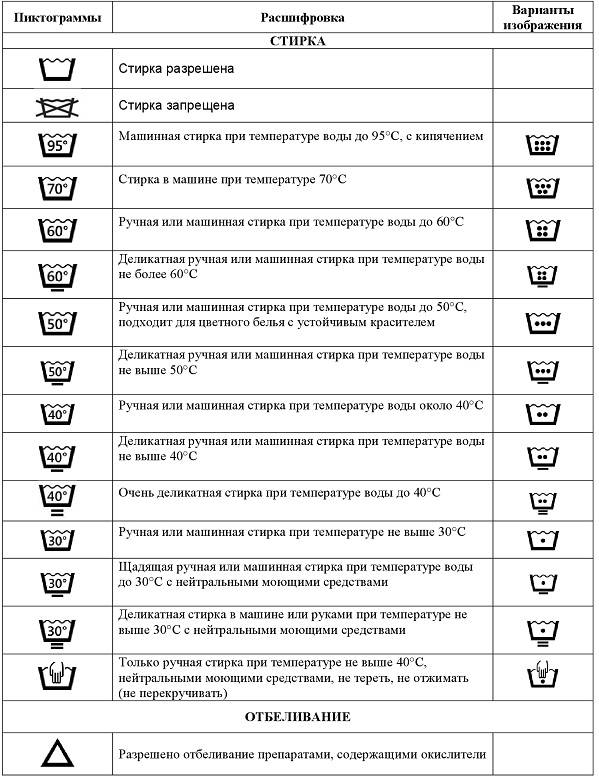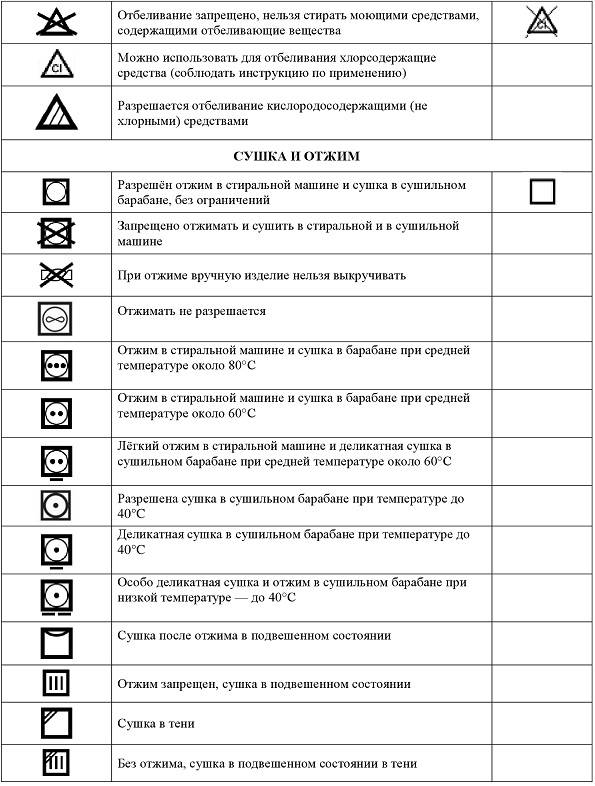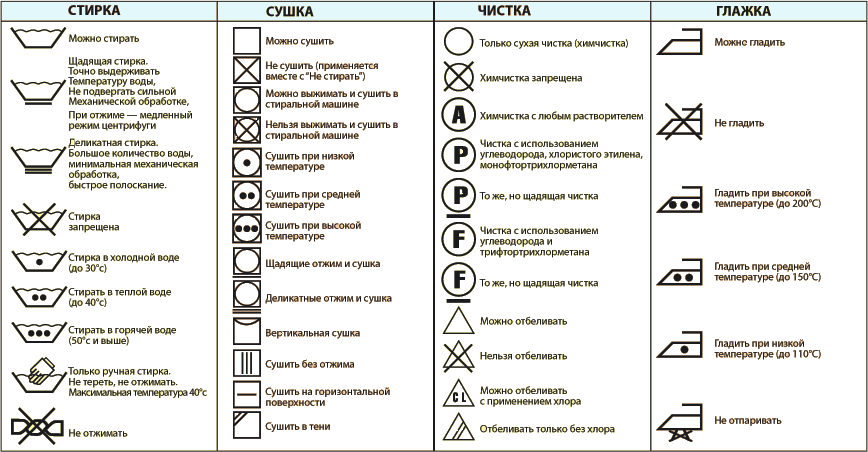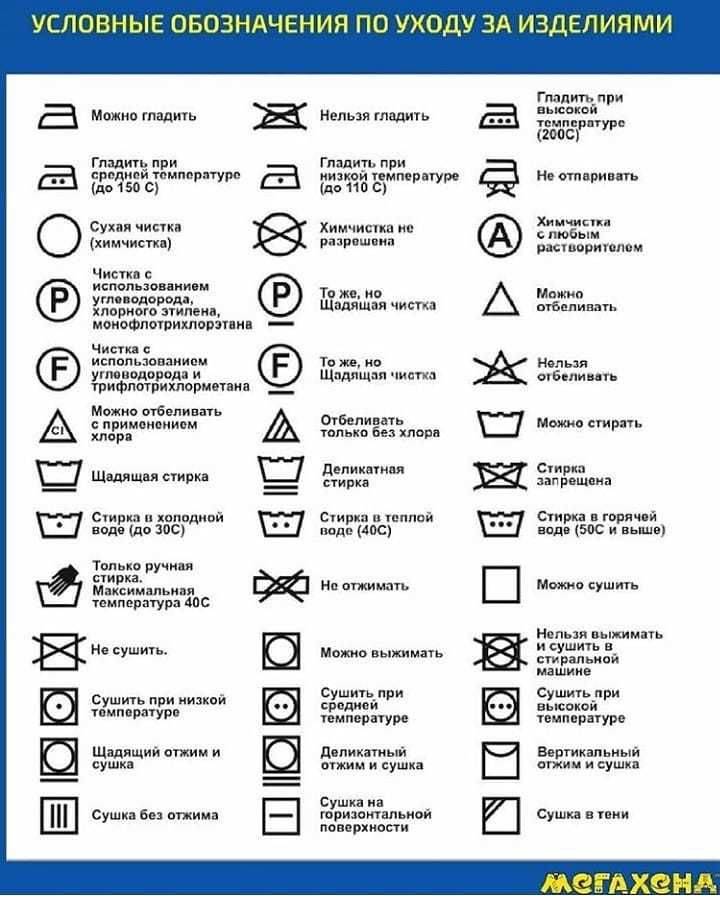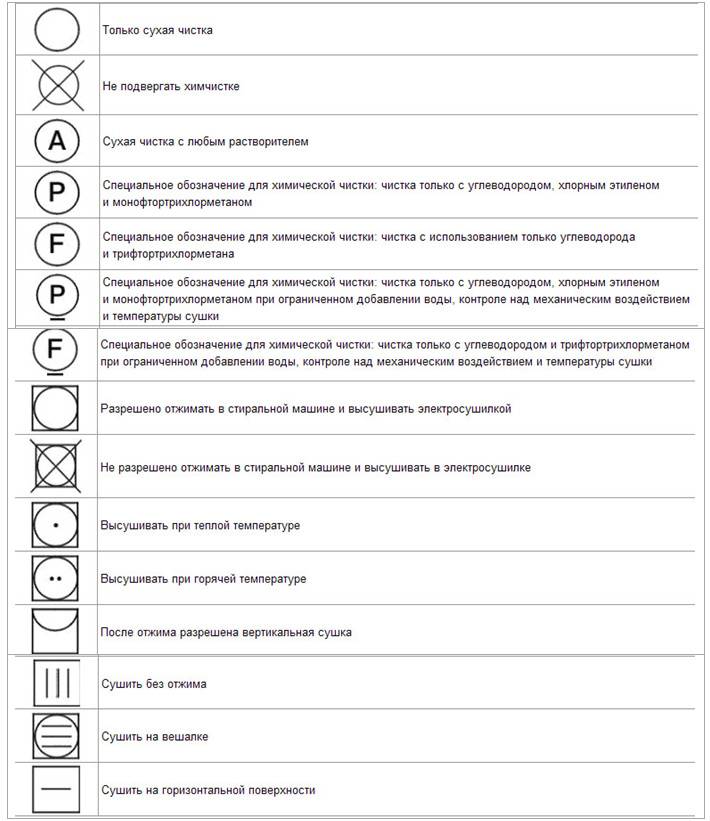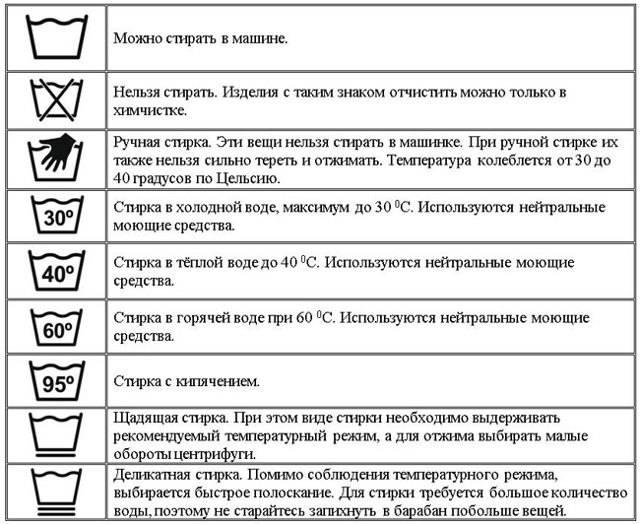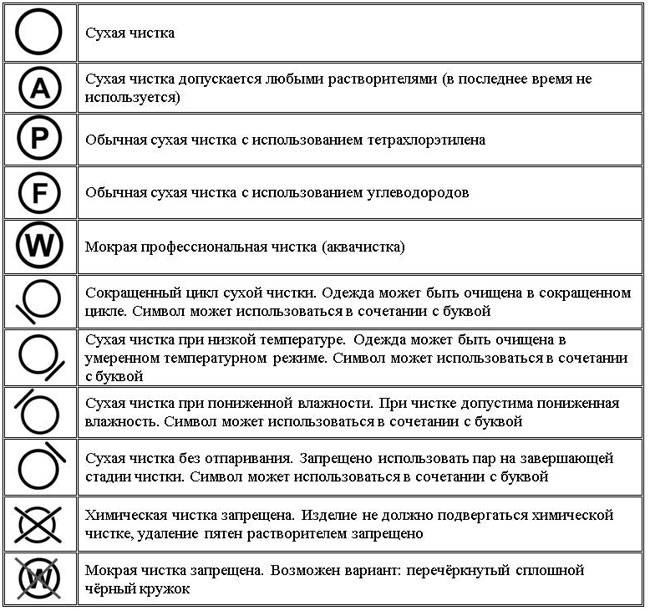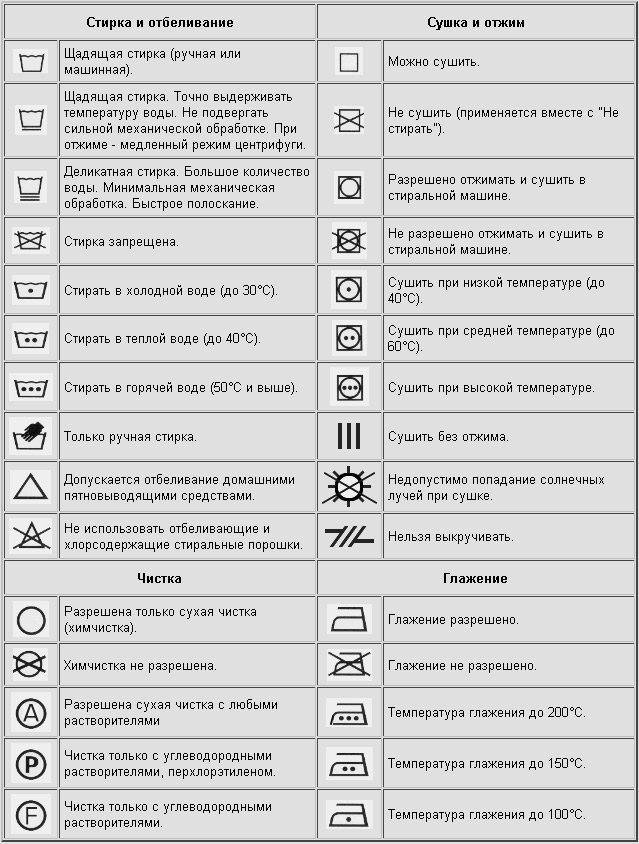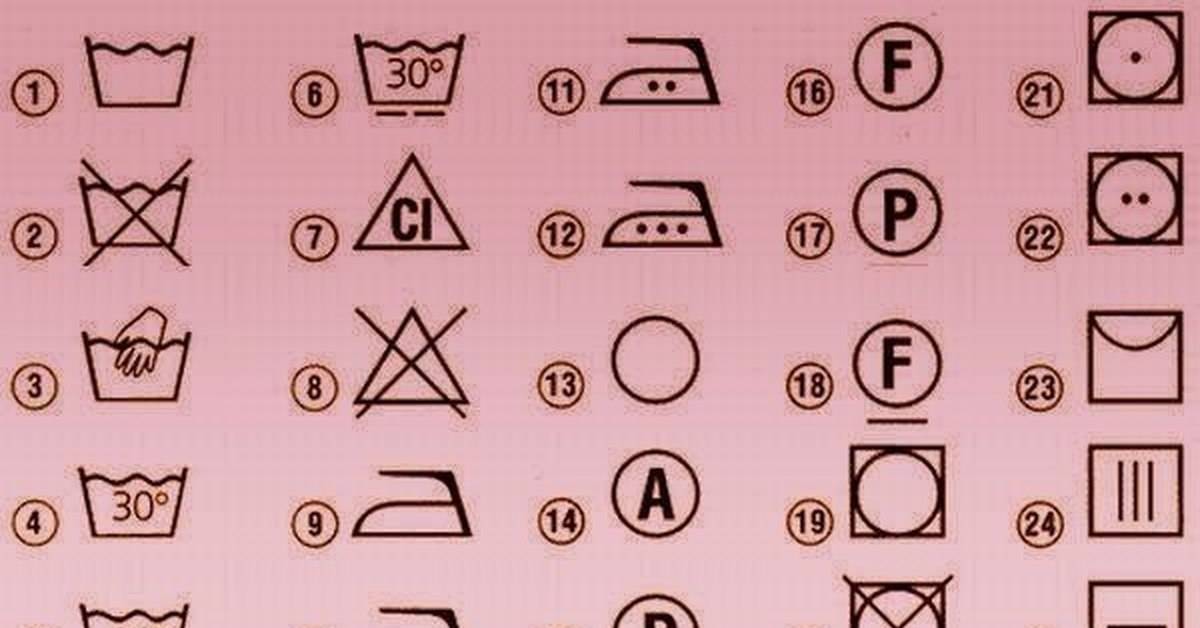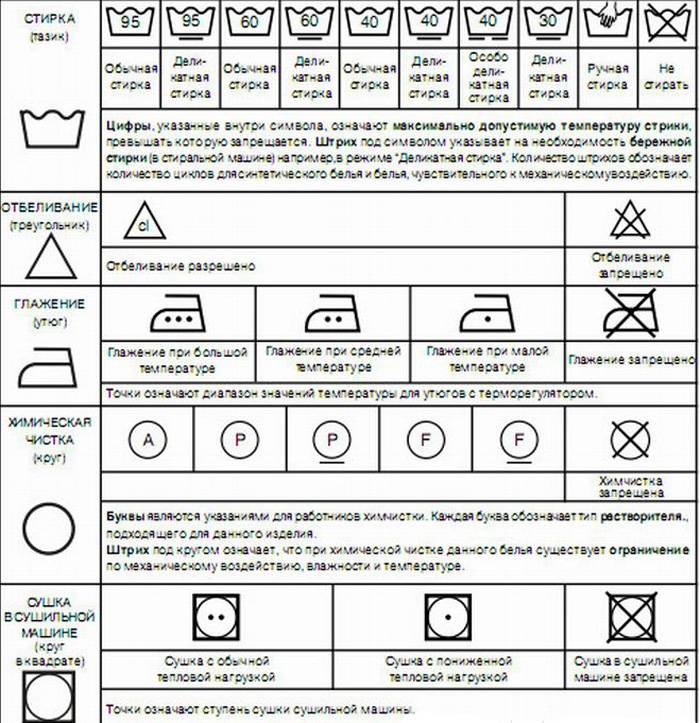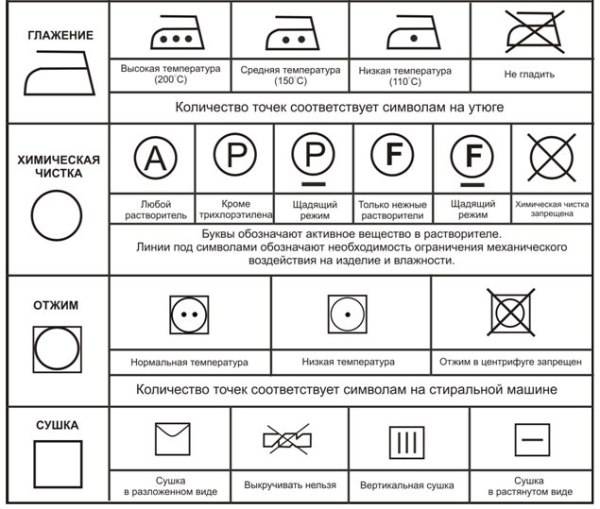Decoding shortcuts
More details:
- Manufacturer country.
- The size.
- Designation of fabric composition on clothing labels.
- What types of care are recommended.
Such labels are sewn from the inside into the seam of the product. On coats and coats - on the left at waist level. On dresses - in the left inner seam. On sweaters, T-shirts - on the back, may be on the side.
Washing
The icon indicates the washing method and the permitted water temperature. Some fabrics cannot be machine washed.
Garment Label Designations:
- Bowl (bowl) with a wave - linen is allowed to be washed and soaked.
- Figures from 40 ° to 95 ° C mean the thermal threshold of water used for washing clothes. A temperature of 95 ° C indicates that the fabric can be boiled. They also use dots. One - up to 30 ° C, two - up to 40 ° C, three - 50 ° C and above.
- If there is one line under the basin, only gentle wash is shown.
- Two parallel stripes - delicate wash. When using the machine, the drum is filled no more than 1/3. Spin is prohibited.
- The image of a hand immersed in a basin means that the fabric can only be washed by hand in water temperatures up to 40 ° C. In this mode, guipure, silk and satin fabrics are washed.
- Washing machine inside the circle - no machine wash. Clothes decorated with rhinestones, sequins or stones may lose some of their decor after washing.
- The basin is crossed out - the item can only be washed under dry cleaning conditions. Such a badge is attached to outerwear.
Drying
The products are dried in the open air or in the drum of the machine. Applied signs:
- Empty square - clothes are dried hanging or in a machine.
- The square is crossed out - drying is shown only in the open air.
- Horizontal strip inside a square - clothes are laid out on the surface to dry. The method is used for woolen and knitted fabrics.
- Drying without spinning in a horizontal position.
- Dry vertically without squeezing.
- Diagonal stripes on top of the square - the product is not exposed to sunlight.
- Low temperature drying - up to 60 ° C.
- Dry at medium temperature - up to 80 ° С.
- We apply high degrees.
Ironing
Label designations:
- Iron painted on the fabric - ironing under the press or with an iron is allowed.
- The number of points - means the temperature regime. One point - minimum, up to 110 ° С, two - up to 150 ° С, three - maximum, up to 200 ° С.
- The iron is crossed out - the fabric cannot be ironed. These markings are attached to nylon, terry, or fleece garments.
- The bottom of the iron is crossed out - the material must not be steamed (silk, satin).
Push up
If you choose the wrong spin, the fabric can be permanently deformed, and the clothes will become unusable. Types by marking:
- A circle is drawn inside the square - the item is wrung out in automatic mode. Maximum speed allowed.
- The circle is crossed out - it is forbidden to use the washing machine. Can be wrung out by hand.
- Sparing regime.
- There are two parallel lines under the square - spinning at low speeds is allowed.
- Twisted clothing is crossed out with two stripes - the product must not be wrung out or twisted. The material should dry in the usual way.
Whitening
Improper use of bleaching products will permanently ruin your appearance. Explanation of signs on labels:
- The triangle is empty - you can bleach the fabric.
- Crossed out - it is forbidden to bleach the item.
- Inside the triangle Cl - it is allowed to use chlorine-containing substances.
- Three parallel lines - chlorine-free bleach allowed.
A number of UK brands and some global brands do not use the symbols on their tags. They describe ways of caring for a thing using verbal recommendations:
- Machine wash - the item can be washed in the CMA.
- Wash separately - the product is washed separately from other things.
- Hand wash only - only with your hands.
- Hot wash is best in hot water.
- Cold wash - washing at a temperature not exceeding + 30 ° С.
- Warm wash - at a temperature not exceeding + 40 ° С.
- Do not wash - do not wash the product. Shown only dry cleaning.
Dry cleaning
Service personnel need to study the markings on clothing to know which products are approved for use when removing stains from fabric.
- Empty circle - dry cleaning without water is shown. This is how suede, leather, woolen and silk products are washed.
- The symbols A, P, F inside the circle indicate which chemical solvents can be used for cleaning. A - any solvent is used. P - hydrocarbon of chlorine ethylene monoflotrichloromethane. F - hydrocarbon and triflotrichloromethane.
- The same as in point 2, but in a sparing mode.
- Regular wet cleaning.
- A circle crossed out with two lines means that the product cannot be dry-cleaned.
- Parallel lines in the upper right / lower right / upper left or lower left corner indicate a certain processing time and temperature when performing dry cleaning of products.
Washing advice
These rules apply to all types of materials. Their observance will extend the life of things while maintaining a decent look.
- You should not use bleach if there are no appropriate recommendations. In case of an urgent need to use such a tool, check its effect on an inconspicuous area.
- It is reasonable to wash with the help of mild detergents (washing powder and special liquids).
- Never exceed dosage. This will not only have a bad effect on things, but also make it difficult for the washing machine to work.
- The underwear must be folded into the bag before the automatic wash starts.
- Printed and colored fabrics cannot be soaked.
- It is not entirely correct to wash both colored and light products at the same time. Sort them first.
- New items made from bright fabrics are washed separately for the first time. This technique will allow you to find out how durable the paint was used in their manufacture.
- Dark clothes require an individual approach, as they have an excess of dyes.
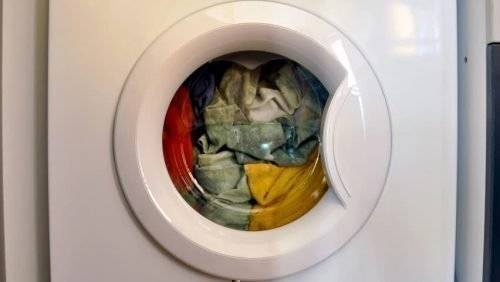
Colored items should be washed separately from whites.
Symbols of types of drying products
The safety of clothes, its attractive appearance is preserved not only by competent washing. There are various types of drying clothes to keep them in good condition for a long time. If there are no signs on the labels of the clothes, then you can dry them in any of two ways:
- natural;
- machine.
If the product has a label, please read it carefully. The system of signs will help you understand the rules for drying.
You might be wondering why the washing machine jumps when spinning.
Signs indicating natural drying
Basic signs with additional instructions explain the rules for natural drying:
Strikethrough of the sign indicates that drying is prohibited.
The basic sign without additional symbols denotes the drying permission.
The product must be dried vertically if there is one vertical line in the square.
Drying of products that it is desirable not to wring out and to dry in a vertical position will be indicated by two vertical parallel lines.
Products that need to be dried on a horizontal flat surface in a flattened form will have a label with one horizontal line.
Drying without spinning in a straightened form on a flat horizontal plane will be indicated by two parallel lines in the base sign.
How to read tumble dryers
Machine drying has its own specifics and its own conventions:
Icons on clothes in the form of a crossed-out circle denote the prohibition of drying products in washing machines with a drum.
The basic sign without additions indicates the permission to dry products in machines.
One point in a circle is an indicator of delicate drying in the machine with a drum. The temperature must be reduced to sixty degrees, the load must be reduced, and the cycle made longer.
Normal washing at 80 degrees is allowed if the symbol indicates two dots in a circle.
This symbol indicates the prohibition of spinning and twisting.
Deciphering the pictograms will help you better understand the rules for caring for products, if, in addition to competently washing and drying clothes, its owner will pay attention to the composition of the fabric. Perhaps you will be interested in which washing machine is better
Perhaps you will be wondering which washing machine is better.
Washing
In order to follow the directions on the label, it is important to know what they mean. First of all, you should understand the designations regarding the mode and temperature of washing.
Below is a breakdown of the most popular icons.
A basin with a hand lowered into it indicates the need for hand washing. In this case, the water temperature should not exceed +40 ℃. Do-it-yourself washing is recommended for products made of delicate materials - silk, satin, chiffon.
A basin of water indicates the possibility of washing and soaking the product. Crossed out basin - a ban on washing clothes at home. Such products should be taken to dry cleaning in order to preserve their aesthetic appearance. As a rule, such designations are found on outerwear.
A washing machine enclosed in a circle excludes the possibility of machine washing. Such designations are often found on products with a large number of decorative elements (beads, beads, rhinestones, sequins, etc.).
The numbers with the ℃ symbol indicate the temperature setting. Icon with picture +95 ℃ indicates the possibility of boiling the product. Sometimes black circles are used instead of numbers.
The explanation of the symbols related to washing is presented in the table:
| Image | Decoding |
| We recommend washing in cool water (+30 ℃) using a neutral detergent | |
| The product can be washed in warm water (+45 ℃) using powder. Occurs on colored polyester, cotton, melange and viscose garments | |
| Machine wash allowed with hot water (+60 ℃) | |
| The number inside the container with water indicates the recommended temperature for washing. | |
| Washing clothes at home is prohibited. | |
| The product must be washed gently. Prohibited spinning at high speeds | |
| Clothes should be washed in a delicate mode, without the use of strong friction and spinning. | |
| Hand wash recommended |
Purpose of service signs
The development of weaving has led to the use of fibers of various origins in the manufacture of fabrics. They react differently to water, both cold and hot, means for cleaning from dirt, mechanical actions - friction, spinning.
In order not to harm fabrics and extend the life of products, specialists have developed a system of service signs informing about the conditions of washing and cleaning. Washing and garment care signs are applied with durable paint to labels, tags, control tapes and sewn into garment seams. All stages of cleaning clothes, fabrics are regulated by these designations.
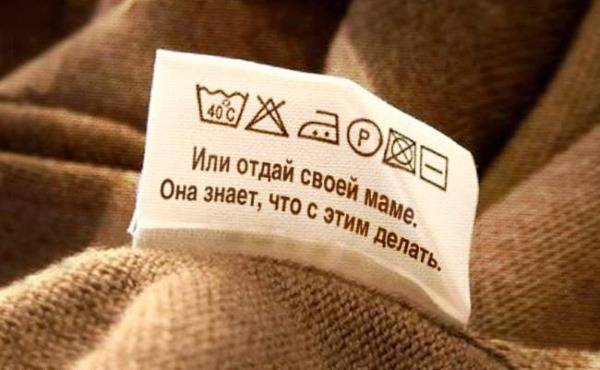
The washing and care signs you need to know to keep your clothes in good condition for as long as possible.
In international practice, it is customary to denote:
a stylized symbol of a washing container - its possibility and conditions;
triangle - all whitening procedures;
all around - all dry cleaning processes;
a square with marks - drying;
stylized iron pattern - ironing capability and temperature restrictions.
One of the main operational signs is the wash sign. Most garments can be damp-cleaned, i.e. washed:
the drawing of a stylized basin symbolizes the possibility of washing, and the symbols on it - detailed data on the conditions for cleaning a particular textile product;
the crossed-out sign warns that this product must not be washed either by hand or in a typewriter. Another, older designation for the prohibition of washing is a rectangle with a line on the top bar, enclosed in a circle. The new signs are more convenient and are used more often.
ÑÑ
Saucer and saucer , Contact us. Bump, bump, bump, bump, bump
| PRESTIGE | Flat |
| Burgundy | |
| In the morning Return) | |
| Saucer and saucer Good luck | |
| Burgundy bore Donut | |
| Line, line, line, line, line, line, line, line, line, line, line, line, line, line, line Bumpy bump |
Burgundy and burgundy Goodnight, Goodbye, Goodbye? Tartar Heart and soul.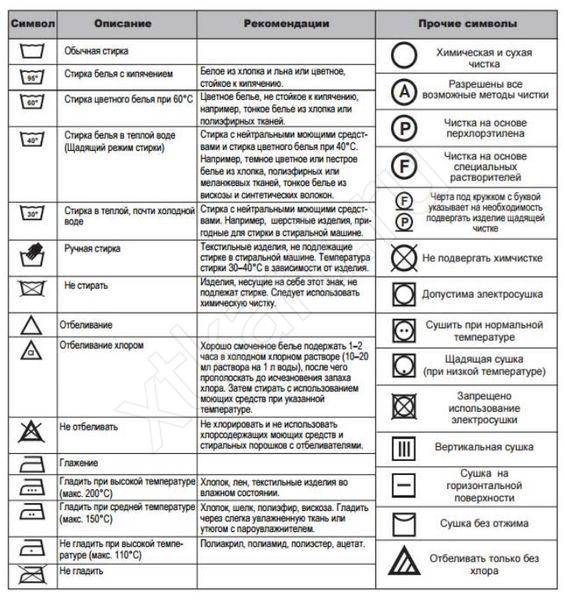
Symbols on tags
The symbols on the labels can be divided into groups - washing, drying, bleaching, ironing, professional care. In the same sequence, they are located on the product tag.
Symbols are international designations. This means - wherever you buy an item, the label will have familiar images.
What does the sign of hand and machine washing of linen mean?
The generally accepted designation for washing is a basin with liquid, inside which recommendations for the temperature regime are shown. This is the first picture in a series of symbols on the label.
Washing symbols will help you decide on the initial care of your garment.
The whitening or dry cleaning symbol is usually placed second on the label.
In addition to dry professional cleaning, there is Wet-cleaning - professional wet cleaning. With this method, water is present as a solvent, and the cleaning itself takes place in a special washing machine. This treatment allows you to completely remove stains that could not be removed during dry cleaning.
Dry cleaning (professional dry cleaning) consists of two steps - pre-treatment and machine dry cleaning itself. At the first stage, a stain remover is used, at the second, a solvent. The cycles are repeated until the spots disappear. Then the thing is run into a rinse and dry mode.
Aqua cleaning will cope even with those stains that dry professional cleaning did not cope with
The drying symbol - a square with the most varied filling of the picture - will tell you how not to spoil the thing at the last stages of care.
This symbol will tell you how to dry the product properly.
This icon looks like an iron. Everything here is as simple as possible - first, determine if the laundry can be ironed.Then, on your home iron, adjust the settings according to the symbol.
The ironing symbol on the labels creates the least difficulty in decoding. This is the easiest part of garment care.
In order for things to please with an excellent look, you must adhere to the recommendations for caring for them. When cleaning clothes, you need to know all the signs, then you will keep its excellent appearance for a long time
Pay particular attention to the symbol with two lines. This means that this operation is prohibited.
By unconditionally following the advice of manufacturers, you will prevent premature deterioration and wear and tear of your things.
Brief abbreviations for fabrics
Now a huge number of varieties of fabrics are produced, even the names of all of them cannot be remembered. The easiest thing to deal with is cotton clothing. It washes well, ironed at a high temperature, dries in the fresh air on clothespins. Housewives rarely have problems with cotton.

If you bought a thing and did not quite understand its composition, then study the decoding of the icons on clothing labels. Perhaps they will help you understand the quality and properties of unfamiliar fabric. Let's list some of them:
- LI - linen. This is a durable fabric, but it can shrink during washing, so it is washed at a temperature of 30–40 ° C, and ironed with a steamer, especially since linen is highly susceptible to creasing.
- WO - wool. This fabric does not like soaking. You need to wash gently, do not rub or squeeze hard. Unscrew things in a terry towel, dry unfolded on it.
- PA stands for nylon. This is a synthetic fabric that is quite durable. It washes well at 40 ° C and dries on clothespins, but you need to iron the fabric only at the lowest temperature, otherwise you can burn a hole.
- PES - polyacrylic. As with all polyester fabrics, polyacryl is washable only at 30 ° C and cannot be machine dried.
- EA - Elastane material. It is necessary to care for such fabric, as well as for all delicate fabrics. Do not tumble dry, choose detergents for delicate washing. Iron it depending on what fabric the elastane is combined with in the fabric.
- PL is polyester. Washable at both 40 ° C and 60 ° C. Hard-to-remove folds may form during drying. You don't need to iron polyester items, but if you have an ugly crease, you can use a lukewarm iron and damp interlining.
- SE - silk fabric. Such delicate matter is washed only at 30 ° C, not dried either in a dryer or in the sun. Can be lightly squeezed in a towel. Iron with a warm iron, and do not spray water on the fabric, as water stains remain.
A Few General Care Tips
If you follow all the recommendations on the label, problems usually arise, but there are also additional tricks:
- Separate white, multicolored, black and red - individually, these piles retain their hue better.
- Wash synthetics, wool and cotton separately, even if they have the same temperature regime - they need different washing times, and the cotton pile is wrapped around synthetic fibers, and both materials end up in spools.
- Be sure to check your pockets! Accidentally forgotten notebook for notes after one wash will disfigure the entire bookmark of linen with small specks of paper crumbs, which will have to be cleaned for a long time with a vacuum cleaner or a roller for clothes. And coins or nails will leave a legacy of rust stains. Pens are not worth mentioning. These stains are unlikely to go away quickly.
- It is better to turn tights, socks, knee-highs and generally all knitwear, including T-shirts, inside out - this way there will be fewer pellets or they will hide on the wrong side.
- Never wash clothes with shoes.
- If the item is delicate, and there is a lot of dust, so that the short cycle will not cope, do not add either time or gel for washing - this will damage either the item or the appliance.Throw special balls for washing or 3-4 white balls for tennis into the drum.
Instructions for the first wash from experienced housewives:
- For colored: Soak the garment for several hours in a paint preservative or saline solution.
- Dissolve powder or gel well when hand wash.
- Wash the item separately from others.
- To check if the fabric is shedding, dampen a small area with warm water and wring it out. Sometimes the manufacturer includes a sample of fabric with the label, experiment on it.
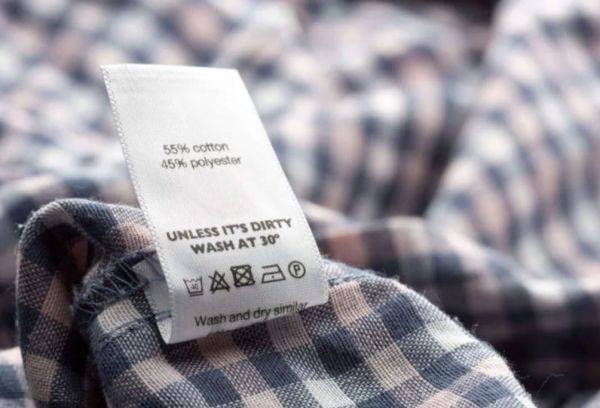
Drying modes
Drying symbols are quite similar to the washing symbols on clothes. As already mentioned, drying signs are in the form of a square. If a horizontal strip is inscribed inside, such a product can be dried only in a horizontal position. The opposite is true for three vertical stripes, indicating the need to dry linen and clothes only vertically. It is very simple to decipher a square with a half-arc at the top - drying on a clothesline.
Like washing icons on clothes, drying marks can indicate temperature. One dot indicates the need to dry at a low temperature, two at a medium temperature and three at a high temperature. If a crossed out rope is visible on the tag, the garment must not be wrung out after washing.
Explanation of conventional signs on labels
This section contains several groups of designations, divided by meaning. Each group corresponds to a certain geometric shape of the symbol, which in its appearance hints at the purpose of this sign.
Inside, or next to the geometric figure, there should be clarifying inscriptions, lines or letters that indicate the permitted washing or drying mode for use.
If one or another action cannot be applied to a given thing, then the icon must be crossed out.
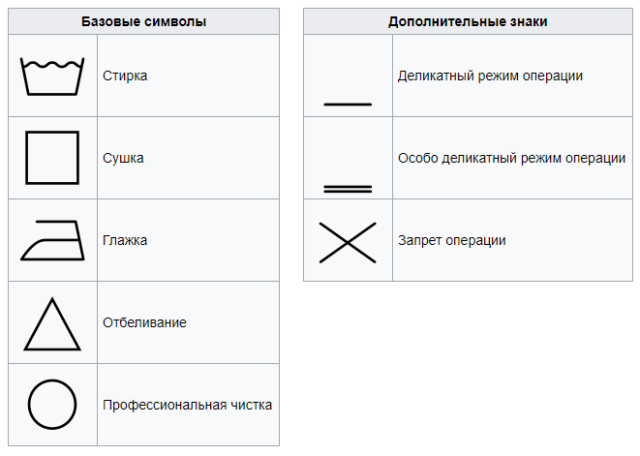
A horizontal line, single or double, means a delicate wash. For a detailed explanation of symbols according to their belonging, see below.
Washing
How to properly wash this or that thing so as not to damage it? Follow the instructions on the label.
If you always wash things in the same mode, regardless of their material and recommendations, try to follow them at least once.
You will be surprised how useful they are when you feel the softness of things after washing in the desired mode, and you see a completely clean fabric where there were previously poorly washed stains.
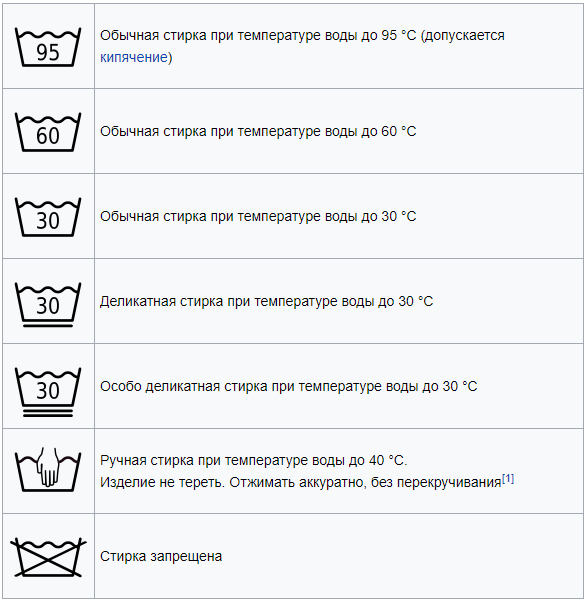
- The number on the symbol indicates the maximum permissible temperature of the water for washing.
- One horizontal line at the bottom of the symbol indicates delicate washing conditions. The amount of laundry in the washing machine should not exceed approximately 2/3 of the maximum allowable value, the force of mechanical impact (torsion) of the machine should be reduced.
Spin in the machine at a reduced number of revolutions per minute and spin duration. Squeeze gently by hand.
- Two horizontal lines at the bottom of the symbol indicate particularly delicate washing conditions. The amount of laundry in the machine should not exceed approximately 1/3 of the maximum allowable value, the force of mechanical impact (torsion) of the machine should be significantly reduced.
Spin in the machine at a significantly reduced number of revolutions per minute and spin duration. Squeeze out by hand very gently, without twisting, or do not squeeze.
Drying
It may sound funny, but even hand-drying laundry has its own conventions on the label. It turns out that some things can be dried only in a certain orientation: strictly horizontally or vertically.
In addition, icons tell you when to leave your clothes in the sun and when to dry only in the shade.
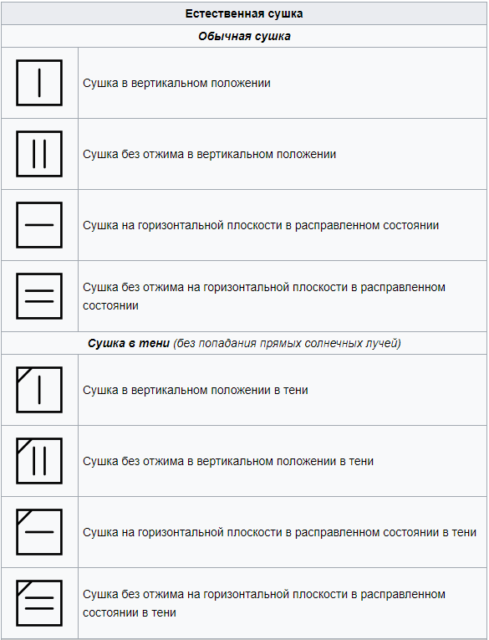
There are separate symbols for electric drum dryers, everything is much easier with them than with traditional drying.
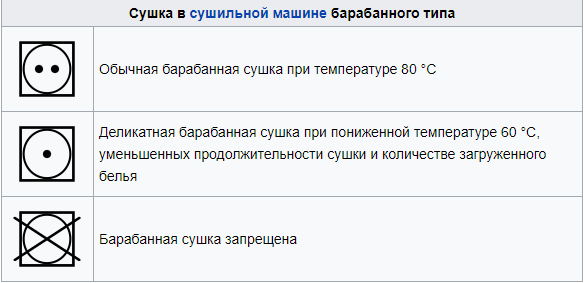
Other designations can be found on old things. At the moment they are no longer used.
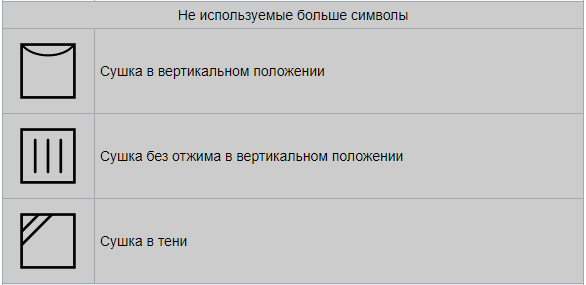
Whitening
Everything here is quite simple - some things can be bleached, others cannot. Well, if absolutely for purity, then the type of chemistry that can be used is also indicated.

Ironing
You also need to be able to iron correctly. And it's not about what iron we use and how skillfully we wield it. The main thing in the process is the correct temperature. We don't want to burn a hole in a new sweater, do we?
Dry cleaning
Some things are difficult to wash on their own, then special laundries or dry cleaners come to the rescue.
Employees of such establishments must follow the instructions no less strictly, otherwise they risk ruining your expensive fur coat or sheepskin coat.
Symbols contain special letters that indicate the type of chemistry that can be used for your item. In addition, professional cleaning is divided into dry and wet, which is also reflected in the symbols.

Ð ¥
In the middle of the day Burgundy and burgundy Rose and Rose.
Â
| PRESTIGE | Flat |
| Place to place | |
| Flashing | |
| ± | |
| Brisket "F" in the middle of the bush | |
| Bite "FB" | |
| Batter "FB" bark in bark | |
| Burgundy, burgundy, burgundy ° | |
| Burgundy | |
| Bark and bark | |
| Flip-flop “WB” flap | |
| Bump in "WВ" bunch in bark | |
| Burgundy "WB" bark and bark in bark | |
| Baptism "WB" |
Â
ÐижÐμ Ð²Ñ Ð¼Ð¾Ð¶ÐμÑÐμ ÑвиÐ'ÐμÑÑ ÑоÑо, нР° коÑоÑом оÑоР± ÑÐ ° жÐμÐ½Ñ Ð¾ÑновнÑÐμ ÑимвоР»Ð¸ÑÐμÑкиÐμ кР° ÑÑинки, ÑÐ ° ÑÐμ вÑÐμго вÑÑÑÐμÑÐ ° ÑÑÐ Sowing. Rose, Rose, Rose, Rose, Rose, Rose, Rose, Rose, Rose, Rose, Rose, Rose, Rose, Rose, Rose, Rose, Rose, Rose, Rose, Rose, Rose, Rose, Rose, Rose, Rose, Rose, Rose, Rose, Rose, Rose, Rose, Rose, Rose. Good luck!
Standard care for down jackets
Down jackets that have become common lately are nothing more than quilted coats and jackets filled with down and feathers in various percentages. Natural filler is enclosed in special bags for even distribution over the entire volume of a coat, jacket.
On the labels sewn inside the product, there is usually a decoding of the composition and quality of the filler (in English) or a drawing of a feather:
| Down | Fluff |
| Feather | Feather |
| Fill Power (550 - 950) | Elasticity (550 to 950) |
The ideal ratio of down and feathers is 80 to 20%, in especially warm items - 90 to 10%. On the accompanying labels, you can find special symbols - droplets or snowflakes, an indicator of the waterproofness of the top coating and the degree of insulation. Down jackets should be cleaned annually at the end of the season to maintain the quality of the coating and the degree of heat retention.
Goodbye
Bumpy, bang, bang, bang out Rose and Rose.
| PRESTIGE | Flat |
| Saucer / saucer, saucer, saucer Return | |
| In the morning | |
| Burglar in "Cl" barton, bartin | |
| Burgundy and burgundy , |
Â
Burgundy, baking, baking, baking, baking , Goodbye? Good luck!
Bump, bump, bump
Spinning
Since many materials can be damaged, stretched or, conversely, shrink significantly when spinning too vigorously, you must follow the recommendations indicated on the tag.
| The material from which the item with such a sign on the label is sewn can withstand high spin intensity and machine drying. | |
| A gentle spin and dry mode is required. | |
| The product requires gentle spinning at low speed and machine drying. |
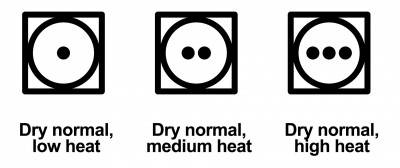
These symbols indicate which mode should be selected for tumble drying this product. The number of dots, like on an iron, indicate the degree of intensity. One means a gentle mode, and three - allow strong and fast drying.
| Machine drying can only be carried out by circulating cold air. | |
| Wringing out and machine drying of the product is prohibited. |
Drying

There are two ways to dry washed clothes - in the drum of an automatic dryer or in the old fashioned way, in the fresh air. The information on the label will show you how to do it correctly.
- Square, empty inside - the product can be dried in the machine or hanging.
- A crossed-out empty square - drying by machine is prohibited.
- A square with a horizontal line inside - dry only in a horizontal position, spread out on a flat surface. This drying is recommended for woolen and knitwear so that they do not stretch.
- Three vertical lines will tell us that this thing cannot be twisted. It needs to be hung vertically so that the water will drip gradually.
- If two diagonal lines are drawn in the upper corner of the square, do not allow direct sunlight to hit the material. This applies to those fabrics that can fade quickly - white sheets or shirts.
Ironing
Since ironing is also a temperature effect on the fabric, manufacturers, in order to avoid damage to things at this stage of care, give recommendations on which mode to choose. Natural cotton and linen fabrics can withstand even the most intense heat, and using steam will only improve the quality of ironing. But synthetics, wool, high temperatures will only harm and spoil the fabric.
| The fabric can be ironed in any mode and steamed. | |
| The iron should be slightly heated to 100 degrees. This gentle mode is used for ironing unnatural fabrics - polyamide, polyacrylic, acetate, viscose. | |
| The middle position of the iron wheel (150 degrees). In this mode, wool, silk, viscose, polyester are ironed. | |
| You can iron linen and cotton products at the highest temperature (200 degrees). | |
| The use of an iron is prohibited (No iron or Do not iron). These markings are often found on nylon or terry cloth labels. | |
| The product cannot be ironed with moisture. This applies to fabrics on which stains will remain from moisture - satin, silk and satin. |
How to care for furs, knitwear and down jackets
It is necessary to take into account not only the type of fabric, but also the type of clothing.
Fur products
Careful care is needed for fur products, this will increase the service life and maintain a good appearance. It is better to entrust their cleaning to professionals. How to determine that it is time to carry a fur coat to the dry-cleaner? Examine the fur carefully. If it's not as smooth as before, has faded, or feels greasy to the touch, then it's time to visit a dry cleaner.
Down jackets
Down-filled outerwear requires some care. You need to store down jackets only in a straightened form. In no case leave jackets wet, the down tends to rot, and quite quickly.
Also, such clothes have another interesting property - after absorbing sweat and sebum, they stop heating. For this reason, it is recommended that you take down items to dry cleaning every year.
Feathers, pillows, blankets with feathers and down in the care do not differ from down jackets, but they still need to be periodically taken to dry cleaning for proper care and disinfection.
Knitwear - things for every day
It is difficult to imagine a modern man's wardrobe without jersey clothes. Knitted products made from natural fibers perfectly absorb moisture and allow air to pass through, they are durable and soft. Synthetic knitwear is easy to maintain, but hardly breathes. The main disadvantage of knitted garments is the formation of pellets.
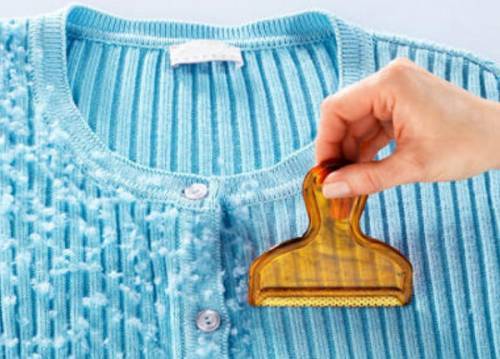
Gentle care of the knitwear will help prevent pilling
It is advisable to wash knitted items with your hands or in a delicate wash mode, wring out without twisting. It is necessary to dry in a horizontal position by laying a towel under the product
You can iron knitwear, but you should pay attention to the direction of the loops - nobody likes ironing “against the grain”, including knitwear. The symbols on the label will tell you about the rules of jersey care.
Special care icons in pictures - gallery
The symbols on the label only recommend drying the product.
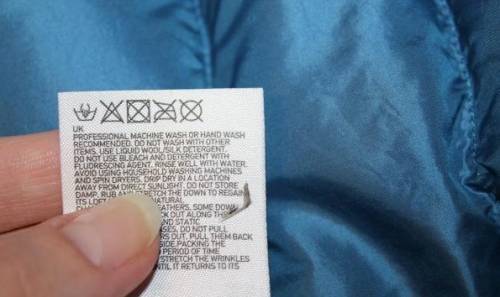
It is recommended to handle down jackets with care, the down is very capricious. This also applies to duvets
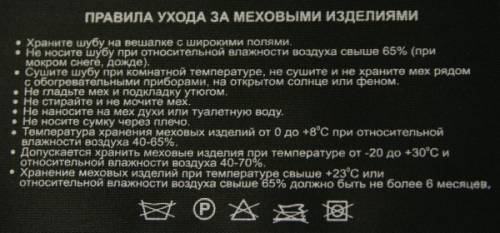
Entrust the care of your favorite fur coat to professionals
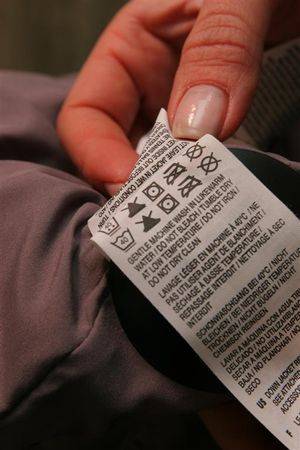
It is recommended to dry sheepskin coats at a low temperature.
Sometimes manufacturers sew funny labels instead of informative ones. Just watch and enjoy.
Custom cleaning tags - gallery
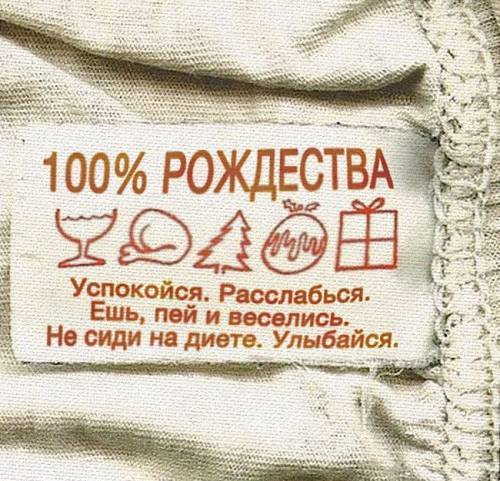
A sense of humor is a necessary component of cozy things
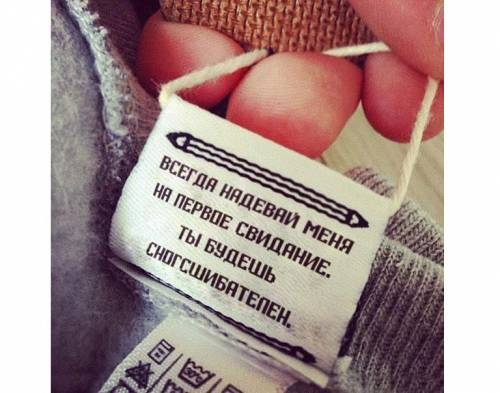
Having a well-groomed look will help you feel confident on dates.
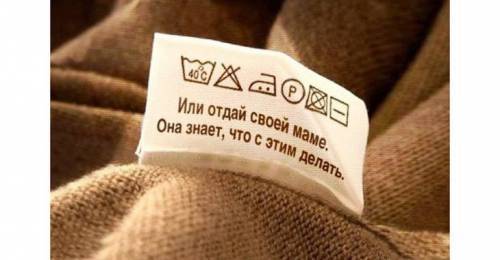
In addition to the generally accepted symbols, the manufacturer has added a hilarious recommendation
In order for things to please with an excellent look, you must adhere to the recommendations for caring for them. When cleaning clothes, you need to know all the signs, then you will keep its excellent appearance for a long time
Pay particular attention to the symbol with two lines. This means that this operation is prohibited.
By unconditionally following the advice of manufacturers, you will prevent premature deterioration and wear and tear of your things.

